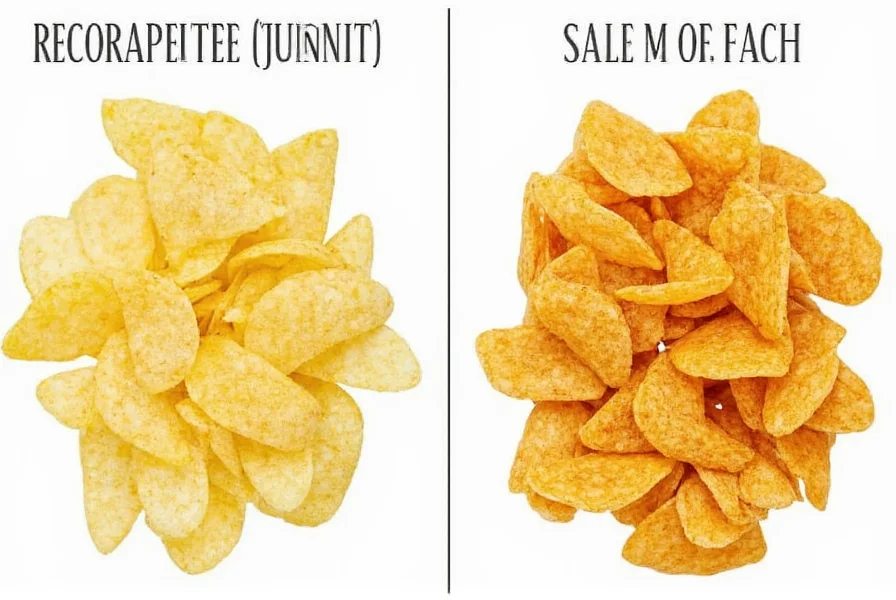Salt and pepper chips represent one of the most beloved savory snack options that transcends regional preferences and cultural boundaries. Unlike more complex flavor profiles, this classic combination relies on the perfect balance between two fundamental seasonings that enhance the natural taste of the potato or alternative base ingredient without overwhelming it.
The Distinctive Flavor Profile
What makes salt and pepper chips stand out from other flavored snacks is their clean, straightforward taste experience. The coarse salt provides immediate savory impact while the freshly ground black pepper delivers a subtle warmth and complexity. This flavor pairing works exceptionally well because:
- Salt enhances the natural starchiness of potatoes
- Freshly cracked pepper offers aromatic complexity without excessive heat
- The combination creates a more sophisticated taste than standard salted chips
- It serves as a versatile palate cleanser between stronger flavors
Food scientists note that the particle size of both seasonings matters significantly. Coarse sea salt crystals adhere better to the chip surface, while freshly cracked pepper provides more volatile aromatic compounds than pre-ground pepper.

Commercial Production Process
Major snack manufacturers produce salt and pepper chips through a carefully calibrated process. After slicing and frying potatoes (or alternative base ingredients), the chips move along a seasoning drum where the precise salt-to-pepper ratio is applied. The industry standard typically uses:
| Seasoning Component | Typical Percentage | Particle Size |
|---|---|---|
| Coarse Sea Salt | 70-75% | 0.5-1.0 mm |
| Freshly Cracked Black Pepper | 25-30% | 0.3-0.8 mm |
This precise formulation ensures consistent flavor delivery across production batches while maintaining the distinctive visual appearance that consumers recognize.
Homemade Salt and Pepper Chips Recipe
Creating authentic salt and pepper chips at home allows for complete control over ingredients and seasoning intensity. For those interested in a homemade salt and pepper chips recipe, follow these professional techniques:
- Select high-starch potatoes like Russets for optimal crispness
- Soak sliced potatoes in cold water for 30 minutes to remove excess starch
- Fry at 350°F (175°C) until golden brown and crisp
- Immediately after draining, season with freshly cracked black pepper
- Add coarse sea salt while chips are still warm for maximum adhesion
- For enhanced flavor, include a small amount of onion powder (optional)
The key to perfect salt and pepper seasoning for homemade chips is applying the seasonings while the chips are still warm but not hot enough to burn the pepper. This preserves the volatile aromatic compounds that give black pepper its distinctive flavor.
Nutritional Considerations
When evaluating the nutritional value of salt and pepper chips, several factors come into play. While the seasoning itself adds minimal calories, the base product determines most nutritional aspects:
- A standard 1-ounce serving contains approximately 150-160 calories
- Sodium content ranges from 120-180mg per serving, significantly lower than many flavored chip varieties
- Contains no artificial flavors or colors in traditional formulations
- Provides small amounts of potassium and vitamin C from the potato base
For those seeking healthier alternatives to salt and pepper chips, consider baked versions using sweet potatoes or kale, though these will have different texture profiles than traditional fried potato chips.
Brand Comparison and Availability
Several major snack manufacturers offer their interpretation of salt and pepper flavored chips. While recipes vary slightly between brands, the most widely available options include:
- Tyrrells British Salt and Pepper Crisps (UK-based, known for premium ingredients)
- Kettle Brand Salt and Pepper Potato Chips (popular in North America)
- McCoy's Salt & Black Pepper (distinctive ridged texture)
- Various store-brand versions available at major grocery retailers
When searching for where to buy these snacks, check specialty grocery stores, international food sections, or online retailers as availability varies by region. The best brands for salt and pepper flavored chips typically use higher quality ingredients and more balanced seasoning ratios than budget options.
Serving Suggestions and Pairings
Salt and pepper chips serve as an excellent neutral base that pairs well with various dips and accompaniments. Consider these pairing suggestions:
- Classic ranch dressing for a balanced flavor combination
- Guacamole for a complementary earthy flavor profile
- As a crunchy topping for soups and salads
- With seafood dishes as a flavorful alternative to plain crackers
Their relatively mild seasoning makes them more versatile than strongly flavored chips like sour cream and onion or barbecue varieties. This versatility explains why many restaurants feature salt and pepper chips as a standard menu option alongside more intensely flavored alternatives.
Understanding Flavor Variations
When exploring the difference between salt and vinegar and salt and pepper chips, note that salt and pepper offers a more universally appealing profile. While salt and vinegar delivers a sharp, acidic punch, salt and pepper provides warmth and complexity without the polarizing vinegar element. This makes salt and pepper chips more accessible to a broader audience while still offering distinctive flavor.

Conclusion
Salt and pepper chips maintain their popularity through a perfect balance of simplicity and sophistication. The enduring appeal of this flavor combination demonstrates how sometimes the most basic seasoning profiles can create the most satisfying snack experiences. Whether purchased commercially or made at home using a reliable homemade salt and pepper chips recipe, this classic flavor continues to satisfy snack enthusiasts worldwide with its clean, savory profile that enhances rather than masks the natural qualities of the base ingredient.
What makes salt and pepper chips different from regular salted chips?
Salt and pepper chips contain freshly cracked black pepper in addition to coarse salt, creating a more complex flavor profile with subtle warmth and aromatic complexity that regular salted chips lack. The pepper adds depth without significant heat, making it more sophisticated than standard salted varieties.
Are salt and pepper chips healthier than other flavored chips?
Salt and pepper chips typically contain fewer artificial ingredients than many flavored chip varieties since they rely on natural seasonings. They generally have slightly lower sodium content than flavors like barbecue or sour cream and onion, but the base nutritional profile remains similar to other potato chips.
Can I make salt and pepper chips with sweet potatoes?
Yes, sweet potatoes work well for salt and pepper chips. The natural sweetness of sweet potatoes creates an interesting contrast with the savory salt and pepper seasoning. When making sweet potato versions, consider reducing the salt slightly to balance the natural sweetness of the base ingredient.
Why do some salt and pepper chips taste more peppery than others?
The intensity of pepper flavor varies based on the type of pepper used, its freshness, and the ratio in the seasoning blend. Higher quality brands use freshly cracked pepper which has more volatile aromatic compounds, while cheaper versions may use pre-ground pepper that has lost some potency. The particle size also affects how much pepper flavor you experience with each bite.
What's the best way to store homemade salt and pepper chips?
Store homemade salt and pepper chips in an airtight container at room temperature. Include a silica gel packet to absorb moisture if possible. Properly stored, they should maintain crispness for 3-5 days. Avoid refrigeration as the moisture will make them soggy. For longer storage, freeze in a vacuum-sealed bag for up to 3 months.











 浙公网安备
33010002000092号
浙公网安备
33010002000092号 浙B2-20120091-4
浙B2-20120091-4